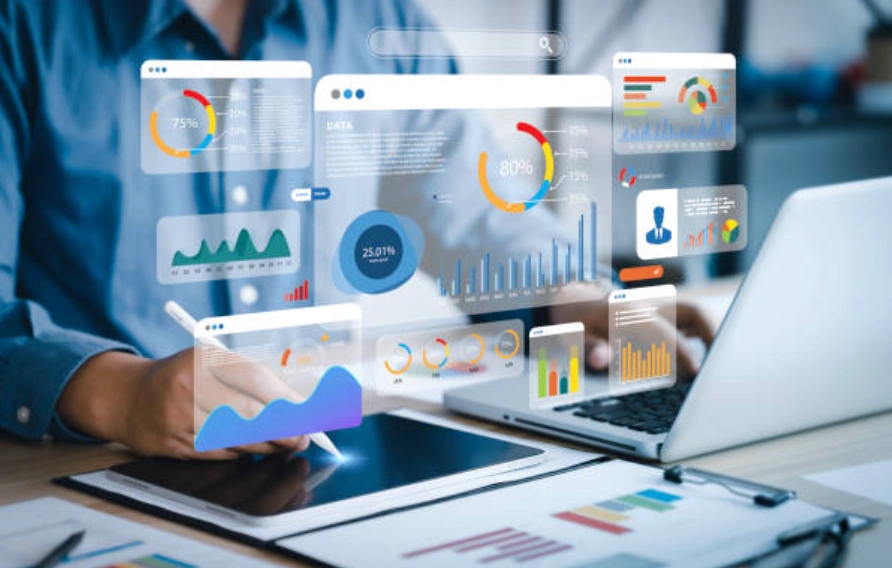We, the Corpsoft.io team, are happy to share our partnership with entrepreneur Gianluca Ferruggia in developing the DesignRush platform, which was created in 2017.
ERP systems are the secret weapon of thriving businesses today. Imagine automating tedious tasks, optimizing your supply chain, and fostering stronger customer relationships – all from a single platform. That’s the magic of ERP system modules!
In this article, we’ve delved into the core modules like finance, manufacturing, and customer relationship management, uncovering how you can boost a company’s productivity and enhance customer and staff satisfaction while reducing business-related costs.
Whether you’re a small business or a large enterprise, you can customize an ERP system to meet your unique needs. So, embark on your journey to unlock the full potential of your business and experience the transformative power of ERP!
What Are ERP System Modules?
ERPʼs are the building blocks of an Enterprise Resource Planning (ERP) system. Those independent software components serve specific business functions. It can be finance, accounting, human resources, manufacturing, supply chain management, etc.
Each module is designed to work seamlessly with the others, sharing data. Accurate data eliminates errors across departments, improving accuracy and saving time spent correcting mistakes.
ERP system modules can help you to calculate all your financial transactions, customer interactions, staff behavior, and more. All you need to do is to find modules that suit your needs.
Top-10 ERP Modules and Their Features
There are hundreds of business tools, so figuring out which ERP types you need boost may be challenging. We understand your concerns. That’s why we created a list of the ten most vital ERP system modules. Pick those that suit your needs and implement them to see the first results.
You can adopt them bit by bit or incorporate them all simultaneously. The choice is up to you. We can help you schedule implementations so you will get all the needed modules while staying within your perfect budget.
💸 📈 Finance
It’s one of the main modules for any ERP system. You should have it even if you are a small business. You can easily scale this module in the future. With it, you get great insights for financial planning and analysis. Here are 6 main features of the finance module in ERP:
- The “General Ledger” tracks all financial operations in your company, from staff salaries and contractor payments to customers’ charges.
- The “Accounts Payable” module tracks all the money you receive from suppliers. Meanwhile, “Accounts Receivable” tracks money that customers owe to a business.
- You should use the “Fixed Assets” sub-module to track the value of a business’s properties and equipment.
- The “Budgeting” tool allows you to track and forecast current and create new budgets.
- With the “Financial Reporting” tool, you can create reports of any complexity, including income statements, balance sheets, and cash flow statements.
All those ERP automation features allow you to estimate the financial side of your business without spending days on manual calculations. This module can help you track your spending, forecast your future cash flow, and analyze the profitability of any action. The article “What Is an ERP Finance Module?” provides more information about the ERP Finance Module and its benefits to businesses.
👷📋 Procurement
It is one of the most crucial ERP components that allows you to optimize an organization’s spending and streamline its acquisition of goods and services. It will show you how to make your procurement more affordable by analyzing real-time pricing and demand. Check its 5 main features:
- With the “Requisition Management” tool, you can create and manage requisitions for goods and services from various departments within your organization.
- Use the “Supplier sourcing” tool to facilitate identifying, evaluating, and selecting qualified suppliers based on criteria you can set manually.
- With the “Purchase Order Management” tool, you can create, send, and track purchase orders with suppliers, ensuring accurate and timely procurement.
- The “Inventory Management” tool tracks your inventory, providing insights into how you can optimize stock, prevent stockouts, and reduce carrying costs.
- The “Invoice Processing” module automates invoice processing and streamlines payments.
This ERP functional module can centralize procurement data for faster processing and decision-making. It also automates most manual tasks, enabling better control and lowering financial and law risks.
👩🏭 🏭 Manufacturing
This module is vital for businesses that produce their goods, as it manages different production aspects. It can help you plan the manufacturing process in detail, from supplies to unloading goods to shops where they meet a final customer. Here are 5 main features of modern manufacturing ERP modules:
- The “Bill of Materials (BOM) Management” tool can define the components and quantities needed for each product, ensuring accurate costing and production planning.
- You can use the “Production Planning and Scheduling” feature to help you plan and schedule production activities based on demand, raw material availability, and capacity, optimizing resource utilization.
- The “Work Order Management” feature automatically creates, tracks, and manages work orders for specific production tasks, ensuring efficient workflow and production execution.
- Use the “Inventory Management” tool to track raw materials, WIP (work in progress), and finished goods inventory levels.
- The “Quality Control” is one of the smallest yet most vital ERP components that manages quality control processes and procedures, ensuring product quality and compliance with standards.
This module is essentially an accounting ERP software for those businesses that produce their own goods. It helps track inventory levels, production capacity, and budgeting behind the manufacturing.
📕 📦 Inventory Management
You should keep track of your inventory to stay profitable. If you buy too much stuff or spend too much on needless logistics, you may find yourself in constant financial loss. That’s why you need to have an inventory ERP system with the 6 following features:
- With the “IItem and Product Master Data” tool, you can get detailed info about every item, including its specifications, costs, and supplier details.
- The “Inventory Tracking” sub-module provides in-depth simultaneous inventory management of multiple locations.
- The “Purchase Order Management” system calculates who, where, and how to buy your products. Later, the system uses those insights to predict future demand and minimize the amount of excessive inventory in your warehouse.
- The “ABC Analysis” tool classifies inventory items based on their value and impact, prioritizing restocking for critical items.
- The “Warehouse Management” tool facilitates most warehouse operations through built-in functionalities like location tracking, barcode scanning, and picking/packing processes.
- You can use the “Serial/Lot Tracking” feature to track individual items or batches (lots). This ERP logistics feature enables you to improve control and traceability, especially for perishable or regulated goods.
All these tools are small ERP accounting systems for businesses that need advanced inventory management. The inventory ERP system saves you a lot of money, as you will always have your top-selling goods while not overspending resources on needless goods.
🧾 📦 Order Management
Those ERP modules consolidate the manufacturing and sales departments into a solid system. Order management systems have the following 6 vital functions of ERP:
- The “Order Capture” tool captures and processes orders from various channels (online store, sales reps, EDI), ensuring accuracy and data consistency.
- Use the “Credit Check and Fraud Prevention” service to minimize risks and protect revenue.
- Use the “Inventory Allocation and Reservation” tool to reserve inventory automatically upon order placement.
- The “Order Picking”, “Order Packing”, and “Order Shipping” tools manage all these processes efficiently, optimizing order fulfillment times.
- Use the “Shipping Calculation” tool to calculate shipping costs and determine how to make this process more cost-effective.
- The “Returns and Exchanges management” feature efficiently handles returns, exchanges, and refunds, ensuring smooth customer service and inventory adjustments.
This system provides insightful reports about order management, fulfillment efficiency, and customer trends. That way, you can develop data-driven decision-making, minimizing the chances of human error.
🏢 👷 Warehouse Management
Warehouse management is a vital aspect for businesses relying on physical products. That’s why you should pick ERP components that can help you with the following features:
- The “Inventory Management” tool tracks inventory levels across your warehouse(s), including location, binning, and stock status, ensuring real-time visibility and accurate fulfillment.
- The “Warehouse Layout and Zoning” tool defines your warehouse layout, zones, and storage locations for more efficient space organization and optimized picking routes.
- Use the “Picking”, “Packing”, and “Shipping” tools to optimize picking processes based on order requirements, helping you to manage shipping workflows for timely delivery.
- The “Cycle Counting” and “Inventory Adjustments” supply chain ERP tools perform regular cycle counts to identify discrepancies and ensure data accuracy, adjusting inventory levels accordingly.
- You can use the “Labor Management” tool to track the warehouse’s employee activity, assign tasks, and monitor performance to optimize labor productivity.
Thanks to this ERP reporting tool, you can optimize warehouse processes, streamline the workflow, and minimize picking times. It’s a scalable solution, so you can implement it in any business, regardless of its size.
🚚 📋 Supply Chain Management (SCM)
It covers all activities linked with goods movement, from creating raw materials to transporting end products to the client. Here are 9 main features of ERP systems for supply chain management:
- The “Supplier Management” sub-tool helps you manage relationships with suppliers, including sourcing, contracting, and performance tracking.
- Use the “Demand Forecasting” module to predict future demand based on various factors in your supply chain.
- The “Procurement” and “Purchasing” services create and manage purchase orders, track order fulfillment, and optimize purchase costs.
- The “Inventory Management” tool helps you track inventory levels across the entire supply chain, optimizing stock levels, preventing stockouts, and minimizing carrying costs.
- Use “Production Planning” and “Production scheduling” services schedule production activities based on demand, resources, and lead times.
- The “Warehouse management” tool helps you to optimize warehouse operations, including receiving, picking, packing, and shipping.
- With the “Transportation Management” tool, you can plan and manage transportation activities, select carriers, optimize routes, and track shipments.
- The “Order fulfillment” tool can manage the fulfillment process, from order capture to delivery, ensuring accuracy and efficiency.
- The “Returns and Exchange Management” service streamlines returns and exchange processes, improving customer satisfaction and managing inventory adjustments.
These ERP system components provide the maximum available automation levels for your business. SCM management tools can track even emerging trends, showing you how to benefit from them.
👱🏽♀️👩🏽🦰👨🏻🦱 Customer Relationship Management (CRM)
Сustomer relationships are the most valuable thing in the modern market. You can buy any ad placement, but you can buy customer loyalty. It’s organic. Excellent customer relations can improve sales by making them regular and more efficient.
By prioritizing customer satisfaction and providing exceptional experiences, you can reduce churn and retain valuable customers for the long term. The ERP CRM can facilitate this process for you since it has these 4 advanced features:
- With the “Sales Management” tool, you manage the sales pipeline, track hidden opportunities, forecast sales, automate tasks, and optimize the sales process.
- The “Marketing Automation” service can help you create and manage targeted marketing campaigns across various channels and personalize your marketing efforts.
- The “Customer Service Management” tool tracks customer interactions and gives you tips on how to provide personalized customer support.
- With the “Customer Data Management” service, you can get a centralized repository of customer data, including demographics, purchase history, and preferences. Later, you can enable personalized interactions.
ERP CRM eases your communication with clients. You, as a business, can create precisely targeted campaigns. Meanwhile, clients can be sure that they can always get the needed product wherever they want to. Sales managers and marketing teams can analyze both business and client-based data to create even more tailored campaigns.
👷🧑💻 Workforce Management
These components of ERP cover all processes related to planning, management, and optimization of the company’s staff. If you set the company’s workforce management right, you have the right people in the right place for an appropriate time that suits all parties involved. This particular tool unlocks the next 5 features of ERP systems:
- The “Time and Attendance” tool tracks personnel’s work hours, including overtime, late arrivals, sick leaves, etc.
- With The “Scheduling and Forecasting” service, you can plan employee schedules according to the latest company needs.
- With the “Budgeting” tool, you can manage labor budgets and track costs associated with payroll and benefits.
- The “Absence Management” tool allows Here, you can track and manage employee absences, including leaves, vacations, and sick days.
- You can use the “Performance Management” tool to track and evaluate employee performance against set goals and expectations.
These ERP features allow you to understand your internal company’s needs better. By using these features, you can determine the strong and weak points of your team. Use this data to make your team even more productive.
🧑💼🧑💻Human Resources Management
It’s vital to keep track of your workers’ mental health. The HRM services are great examples of ERP tools that may look unnecessary at first sight while ending up being one of the most essential parts of the whole workflow. These features can help you find a common language with the staff:
- The “Recruitment” tool can show you how to change your recruiting strategy.
- With the “Onboarding” service, you can gather all the needed information in one place so new hires can learn the data faster.
Some HRM ERPs allow employees to track how the company executes its promises of providing benefits, including insurance, retirement, and PTO.
You can use the HRM tools to figure out the mental health of your team members and how you, as an employer, can improve it. These features of ERP systems allow you to create a trustworthy work environment that benefits the company in the long run.
Choosing the Right ERP System Modules for Your Business
These 10 modules can skyrocket your business productivity. However, we recommend you to carefully choose those which suit you most. Not every business needs all ERP modules.
Corpsoft.io team can help you pick and develop custom ERP services that perfectly suit your business needs. We have ERP system development tools that allow us to create a system of any complexity, from easy mini-apps to complex enterprise-level solutions.
We can help you achieve your business goals and optimize processes by developing ERP for sales, industrial ERP, and other systems that suit your company’s needs. Contact us right away to get an estimate of the timing and investments required.
Subscribe to our blog


